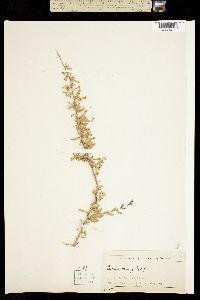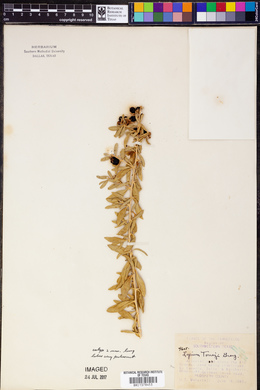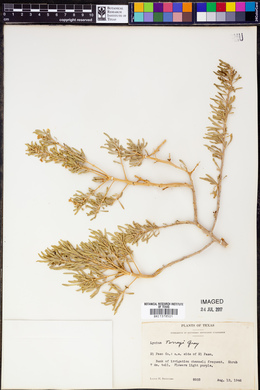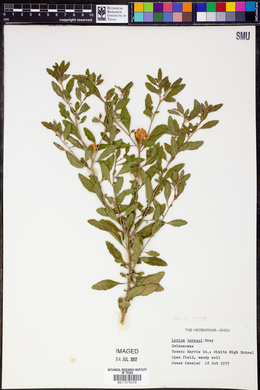Lycium torreyi
|
|
|
|
Family: Solanaceae
Torrey wolfberry, more...Torrey's wolfberry
|
PLANT: Shrub 1-3 m tall, much branched, spreading, with yellowish tan to brownish bark, unarmed or with few thorns. LEAVES: pale green, somewhat succulent, spatulate to oblanceolate or obovate, acute or obtuse at the apex, 1-3(-5) cm long, 0.3-1(-1.5) cm wide, attenuate at base to a petiole 2-4 mm long. FLOWERS: abundant, in groups of 1-6(-8), on slender pedicels 5-20 mm long; calyx cup-shaped to tubular, 2.5-6 mm long, glabrous to sparsely pubescent, the lobes 5, triangular, 1/4 to 1/2 the length of the tube, their margins lanate-ciliate, glabrescent with age; corolla-tube narrowly obconic, 8-15 mm long, constricted at top of ovary and flared slightly at summit, 1.5-2 mm diameter at base, 3-4 mm diameter at top, greenish lavender or whitish, usually glabrous externally but sometimes with few scattered hairs, the lobes 5(4), rounded to oval or lanceolate, 2-4 mm long, spreading, densely ciliate-1anate with branched hairs which are apparent to the naked eye as a tiny white fringe; stamens unequal to subequa1, usually exserted; filaments adnate to about the middle of the corolla-tube, from rather densely to sparsely hairy on basal 1.5 mm of their free portion, adjacent corolla-tube also hairy; style longer than the stamens, usually exserted 2-3 mm. FRUITS: ovoid, 6-12 mm long, bright red, 8-30-seeded (Fig. 2H). n = 12. NOTES: River bottoms and alluvial flats in deserts of the Southwest (Fig. 3B): Coconino, Maricopa, Mohave, Pima, Pinal, Yuma cos. (Fig. 1I); 50-1000 m (100-3300 ft); Mar-May; s CA to TX, NV, UT; n Mex. Wiggins 1964, Benson and Darrow 1981, Kearney and Peebles 1969, Chiang 1981, Chiang and Landrum 2009, Nee 2016 Common Name: Torrey wolfberry Duration: Perennial Nativity: Native Lifeform: Shrub Wetland Status: FAC General: Much-branched, spreading to erect shrub, 1-3 m tall; unarmed or with a few heavy, terete spines 5-10 mm long; bark yellowish-tan to brown; branches leafy and glabrate. Leaves: Short-petioled and in clusters of a few leaves, the clusters alternate along the stems; blades elliptic to spatulate, 1-5 cm long by 3-15 mm broad, light green and glabrous. Flowers: Abundant, in groups of 1-8, on slender pedicels 5-20 mm long; calyx cup-shaped to tubular, 2-6 mm long, 2 mm in diameter at anthesis, sparsely puberulent when young but soon glabrous, topped with 5 triangular lobes, these one-forth to one-half as long as the calyx tube, with densely ciliate-lanate edges; corolla greenish lavender or whitish, the tube narrowly obconic, 8-15 mm long, constricted at top of ovary, flared slightly at summit, and topped with 5 rounded or lanceolate lobes (occasionally only 4 lobes), these 2-4 mm long and spreading, the edges densely ciliate-lanate with branched hairs which are apparent to the naked eye as a tiny white fringe; stamen length about equaling corolla lobes; filaments fused to lower half of corolla tube, densely pilose on basal 1.5 mm of free portion; adjacent corolla tube also pilose. Fruits: Berries ovoid, 6-10 mm long, bright red, 8-30 seeded. Ecology: Found in river bottoms and on alluvial flats, often in alkaline soil, below 3,500 ft (1067 m); flowers March-May. Distribution: s CA and s NV to w TX; south to n MEX. Notes: This species has an interesting distribution, being found primarily in the vicinity of the Southwest's major rivers-- the Colorado, Virgin, Gila and Rio Grande-- without being restricted to those rivers' floodplains or river bottoms. L. torreyi's berries are juicy and more sweet and palatable than other species. It is distinguished from other Lycium spp. by the few heavy spines, 5-10 mm long; the glabrous, light yellowish green leaves; the stamens about as long as the corolla lobes; the flowers 8-15 mm long with short calyxes 1/4 as long as the flower and even shorter calyx lobes 1-2 mm long. Pay attention to the margins of the corolla lobes-- they are densely ciliate-lanate with branched hairs and appear fuzzy even without the aid of a hand lens. Use that fuzzy corolla margin, combined with the flatter, less succulent leaves to distinguish this species from the otherwise similar L. andersonii. Ethnobotany: Used as a ceremonial emetic; for toothaches and chickenpox; the berries were eaten raw or cooked. Etymology: Lycium is from Greek name Lykion used to describe a thorny tree or shrub; torreyi is named for the great American botanist/chemist John Torrey (1796-1873). Synonyms: None Editor: SBuckley 2010, AHazelton 2016 |



































































